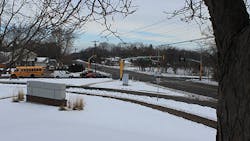Regional solicitation funding supports Twin Cities bicycle network
The Metropolitan Council adopted the Regional Bicycle Transportation Network into the 2040 Transportation Policy Plan in 2015, which prioritized potential bicycle corridors that improve connections and provide safe and comfortable bikeways for all kinds of cyclists, especially those who rely on bikes for transportation.
The network was then introduced as a scoring measure for securing federal funds through the Regional Solicitation. Projects that contribute to building out this regional system are given scoring priority in the multiuse trails and bicycle facilities category, as well as for trails added to potential roadway projects.
Bloomington builds key north-south connector
In 2016, Bloomington applied for and received Regional Solicitation funding for the three-mile France Avenue trail project from Old Shakopee Road to West 84th Street. Serving an area with dense population and employment centers, this project closed a transportation gap in the bicycle network and built essential connections for the community.
“This corridor was identified in the Met Council bike network as a tier 1 corridor,” said Amy Marohn, Bloomington civil engineer. “We knew that it needed a really good treatment. We had some existing sidewalks and trails, but we had big gaps in critical areas along the wetland.”
The existing right of way on the west side of France included a collection of sidewalks, narrow trails and paved shoulders with spaces in between them. This pieced-together system did not give walkers and cyclists reliable protection from traffic, and there was little room on the trail to separate cyclists and walkers. The pavement was also cracked, overgrown with plants and well beyond its useful life.
Trail advances bicycle travel throughout Bloomington and region
“We know that north-south corridors [in Bloomington] are limited for good bike access,” said Marohn. “So, we knew that we needed to prioritize one of them. As construction’s been underway, people have been very interested in it and we’ve gotten positive feedback.”
The reconstructed 10-foot-wide, off-street trail is separated from France with a five-foot boulevard and includes a new boardwalk crossing Nine Mile Creek. This provides a much safer space, separating people from a roadway that has a posted speed limit of 45 mph and upwards of 17,000 vehicles per day.
The project provided much-needed safety improvements at key crossings. Five intersections along the trail corridor have high numbers of crashes: West 84th Street, West 90th Street, West 98th Street, West 102nd Street and Old Shakopee Road. Enhancement of these intersections included high visibility pavement markings; additional signage; wider crosswalks and curb ramps; traffic signals with walk indicators and crossing buttons; and better sight lines so drivers can see people using the trail. The sum is an improved and overall safer experience for walkers, cyclists and drivers.
These improvements are vital considering that this trail is also a connecter to schools. Thomas Jefferson High School, Olson Middle School, Westwood Elementary School and Normandale College are all on or close to the trail.
“People who live within a mile and a half of the high school and middle school don’t have transportation provided,” Marohn said. “If they don’t have cars, they need a safe, accessible way to get there.”
France Avenue is also an active transit route, served by many express and local bus routes. The project improves transit stops with accessible, widened sidewalk connections at high-use bus stops, and new concrete pads for bus stop benches.
Incorporating feedback, reapplying can secure funding
With each solicitation, the Transportation Advisory Board considers many inputs into the funding decision. The board works collaboratively, making compromises to create a program that best serves the region.
This was not Bloomington’s first regional solicitation application for this project, according to Marohn.
“Don’t be afraid to apply more than one time,” she said. “You usually get a lot of really good feedback and information after the first time applying for a project that can help tailor it to be an even better project.”
Evaluating the benefits of transportation projects
Over the years, the Regional Solicitation process has delivered many projects that have contributed significant transportation benefits to the region. In 2019, transportation planners at the Met Council completed a study of Regional Solicitation projects dating back to 2007 to document these benefits. For multi-use trail projects overall, the study showed:
Pedestrian and bicycle crashes have been reduced within the vicinity of the built projects.
More than 60 new miles of bikeways have been added to the region’s Regional Bicycle Transportation Network through the Regional Solicitation funding, either as stand-alone trail projects or as part of roadway projects.
Projects have made critical connections to major job and activity centers, creating links especially for those living in areas of concentrated race and/or poverty.

